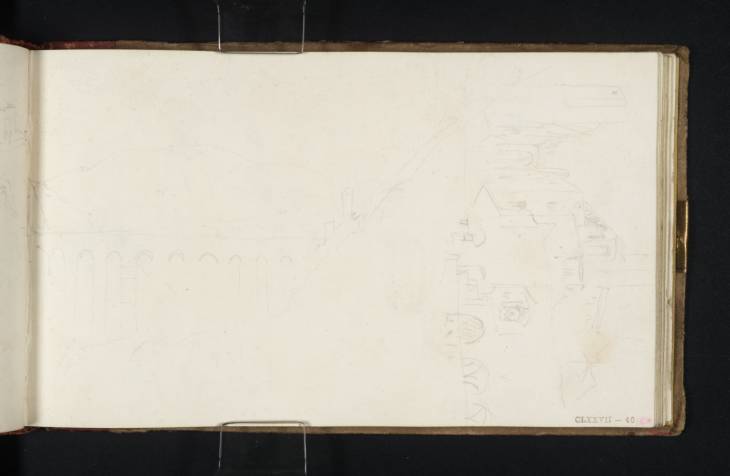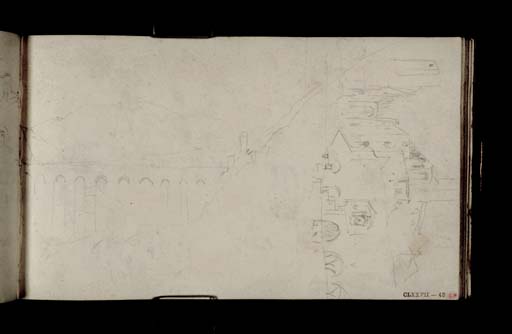Joseph Mallord William Turner The Ponte delle Torri, Spoleto, from the Road to Rome; and a Street below the Torre dell'Olio 1819
Image 1 of 2
Joseph Mallord William Turner,
The Ponte delle Torri, Spoleto, from the Road to Rome; and a Street below the Torre dell'Olio
1819
Joseph Mallord William Turner 1775–1851
Folio 40 Recto:
The Ponte delle Torri, Spoleto, from the Road to Rome; and a Street below the Torre dell’Olio 1819
D14730
Turner Bequest CLXXVII 40
Turner Bequest CLXXVII 40
Pencil on white wove paper, 110 x 186 mm
Inscribed by John Ruskin in red ink ‘40’ bottom right
Stamped in black ‘CLXXVII 40’ bottom right
Inscribed by John Ruskin in red ink ‘40’ bottom right
Stamped in black ‘CLXXVII 40’ bottom right
Accepted by the nation as part of the Turner Bequest 1856
References
1909
A.J. Finberg, A Complete Inventory of the Drawings of the Turner Bequest, London 1909, vol.I, p.522, as ‘Do. [Spoleto.]’.
1968
Giovanni Carandente, ‘Un Viaggio di Turner in Umbria’, Spoletium: Rivista di arte, storia e cultura, no.13, April 1968, p.21, reproduced p.17 fig.7, as ‘Una via di Spoleto (in basso il Ponte delle Torri)’.
1972
Werner Haftmann, Andrew Wilton, Henning Bock and others, J.M.W. Turner: Gemälde Aquarelle, exhibition catalogue, Nationalgalerie Staatliche Museen Preußischer Kulturbesitz, Berlin 1972, p.114.
1975
Graham Reynolds, Turner 1775–1851: zhivopis', risunok, akvarel', exhibition catalogue, Hermitage Museum, Leningrad 1975, p.48.
1982
Evelyn Joll and Martin Butlin, L’opera completa di Turner 1830–1851, Classici dell’arte, Milan 1982, p.200 under no.418.
1984
Martin Butlin and Evelyn Joll, The Paintings of J.M.W. Turner, revised ed., New Haven and London 1984, p.304 under no.518.
1984
Cecilia Powell, ‘Turner on Classic Ground: His Visits to Central and Southern Italy and Related Paintings and Drawings’, unpublished Ph.D thesis, Courtauld Institute of Art, University of London 1984, pp.101, 469 notes 139 and 143, 352 note 19, 409, as ‘Spoleto, from the road to Rome’.
1987
Cecilia Powell, Turner in the South: Rome, Naples, Florence, New Haven and London 1987, p.34.
2008
James Hamilton, Nicola Moorby, Christopher Baker and others, Turner e l’Italia, exhibition catalogue, Palazzo dei Diamanti, Ferrara 2008, pp.44, 90 note 29.
2009
James Hamilton, Nicola Moorby, Christopher Baker and others, Turner & Italy, exhibition catalogue, National Galleries of Scotland, Edinburgh 2009, pp.42, 150–1 note 29.
The Umbrian town of Spoleto lies thirteen miles from Foligno, approximately half-way on the nineteenth-century route between Ancona and Rome. As was often the case during this tour, the progress of the carriage did not give Turner much opportunity to stop and explore the centre of the town. He simply followed a predetermined course around the perimeter of Spoleto and consequently his sketches only depict subjects he could see from the road. This page contains two separate drawings which follow this principle.
The first view was drawn with the sketchbook held vertically like a notebook, and depicts a small street with the base of the thirteenth-century Torre dell’Olio. Turner has added the top of the tower separately on the far left-hand side. The street is the present-day Via Della Posterna, a road on the west side of Spoleto which leads up the hill towards the upper town and which remains virtually unchanged today. In the bottom right-hand corner Turner has recorded a house with a vaulted undercroft and a window with the shutters thrown back, where he has inscribed ‘W’, probably for the white wall, and ‘R’ or ‘B’ for what may be flowers on the ledge. This building is today a trattoria.1 Turner’s viewpoint is from the intersection with the road leading around the perimeter of the old walls, the Via Interna delle Mura. His route then continued on to rejoin the Via Flaminia to the south of the town, the vantage point for the second sketch on the page, which is part of a panoramic view of the Rocca Albornoziana and the medieval aqueduct spanning the Tessino gorge, the Ponte delle Torri. The view continues on the opposite sheet of the double-page spread, see folio 39 verso (D14729).
The Ponte delle Torri (Bridge of Towers) was built during the thirteenth century and derives its name, from the guard towers on either side. Visible on the right of this sketch is the Torre dei Mulini. Designed by Matteo Gattapone of Gubbio as an aqueduct to carry water from Monte Luco on the right to the town on the left, the bridge is 230 metres long and 80 metres high and provided an escape route from the adjacent castle when Spoleto was under siege.2 The impressive scale of the architecture combined with the dramatic scenery of the surrounding terrain made the bridge and the Rocca an obvious picturesque subject for artists, and the road to Rome from the south was a popular vantage point from which to survey the topography. Turner had probably seen James Hakewill’s drawing, The City of Spoleto 1817 (British School at Rome Library) which adopts a similar composition.3 Another sketch from the south can be seen on folio 43 (D14736). See also folio 41 (D14732) for an alternative view and its connection to the late oil painting, The Ponte delle Torri, Spoleto, (formerly Bridge and Tower) circa 1840–50 (Tate, N02424).4
Nicola Moorby
November 2008
Ros Belford, Martin Dunford, Celia Woolfrey et al, Rough Guide to Italy, New York, London and Delhi 2007, 8th edition, p.665.
How to cite
Nicola Moorby, ‘The Ponte delle Torri, Spoleto, from the Road to Rome; and a Street below the Torre dell’Olio 1819 by Joseph Mallord William Turner’, catalogue entry, November 2008, in David Blayney Brown (ed.), J.M.W. Turner: Sketchbooks, Drawings and Watercolours, Tate Research Publication, December 2012, https://www


